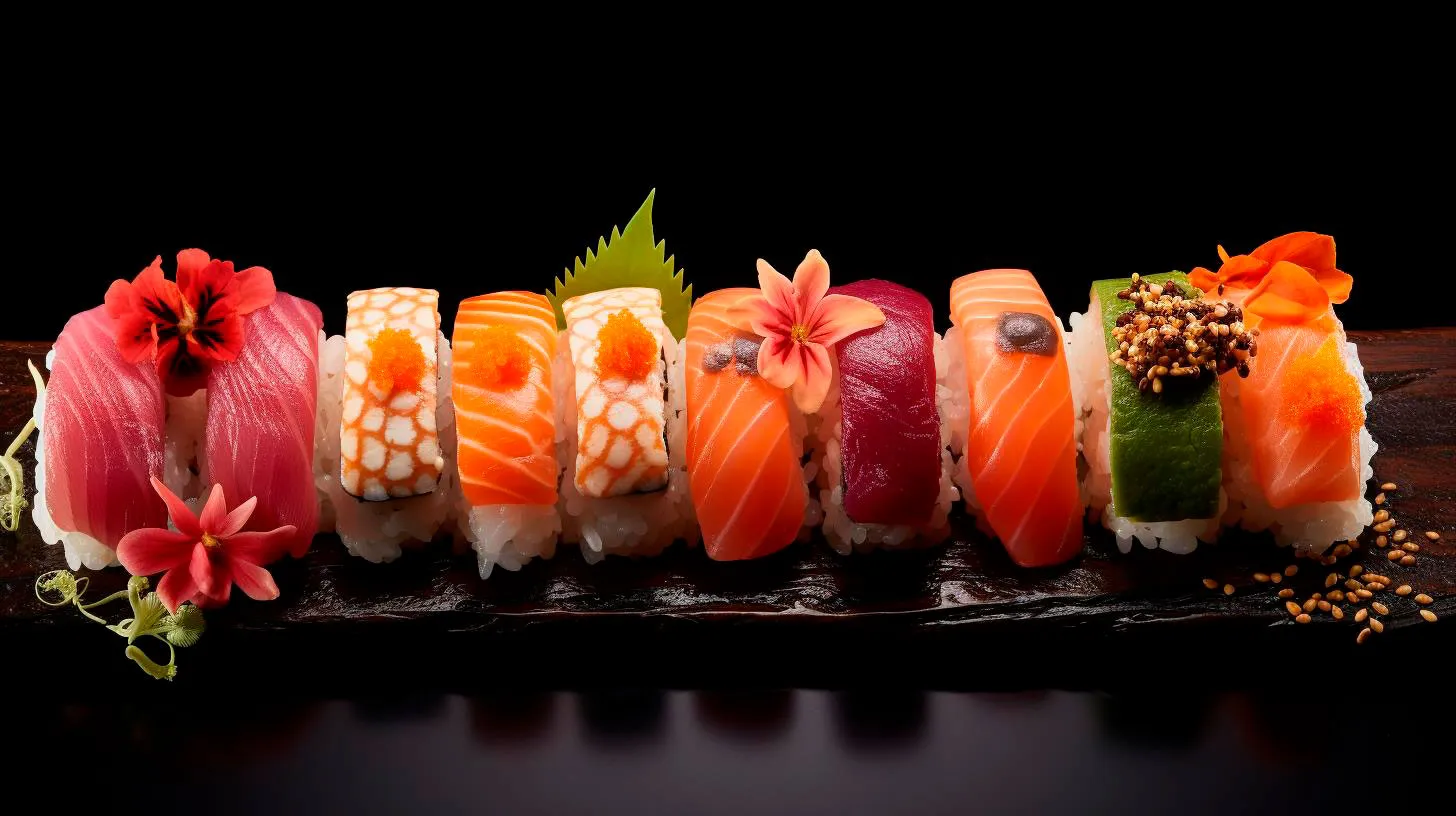Preserving Tradition: Unveiling the Cultural Significance of Sushi Rice Vinegar
In this article, we delve into the fascinating world of sushi rice vinegar, exploring its cultural significance, role in the sushi-making process, and its unique composition. Join us as we uncover the secrets behind this essential condiment.
The Origins: A Taste of History
The roots of sushi rice vinegar can be traced back to ancient Japan. It was originally created as a means to preserve the rice, which was a valuable staple food in Japan. The vinegar was added to the rice to prevent spoilage and extend its shelf life. Over time, this preservation technique evolved into an integral part of Japanese cuisine, particularly in sushi preparation.
The traditional method of making sushi rice vinegar involves fermenting rice wine or sake and letting it naturally turn into vinegar over time. This natural fermentation process gives the vinegar its distinct aroma and flavor, setting it apart from regular vinegar.
The Art of Sushi Rice Vinegar: A Careful Blend
Sushi rice vinegar, also known as “sushizu,” is not your ordinary vinegar. It is carefully crafted to strike the perfect balance of acidity, sweetness, and umami, elevating the taste of every sushi roll it graces. The key ingredients used in making sushi rice vinegar include rice wine vinegar, sugar, and salt.
Here’s a breakdown of the unique composition of sushi rice vinegar:
- Rice Wine Vinegar: The core ingredient that imparts the distinct flavor and tanginess to the sushi rice.
- Sugar: Balances the acidity of the vinegar and adds a touch of sweetness to enhance the overall taste.
- Salt: Adds depth to the flavor profile and ensures the sushi rice achieves the perfect balance of taste.
The precise combination of these three ingredients is a well-guarded secret, often varying from region to region and even from one sushi chef to another. It is this delicate harmony of flavors that gives sushi rice its authentic taste and makes it a culinary masterpiece.
The Role of Sushi Rice Vinegar in Sushi Making
While sushi rice vinegar is essential for making sushi, its role goes beyond mere seasoning. It plays a significant part in achieving the proper consistency and stickiness of the rice, allowing the sushi to hold its shape and making it easier to handle during sushi preparation.
Here are some key takeaways on the role of sushi rice vinegar in sushi making:
- Seasoning: Sushi rice vinegar adds flavor and enhances the taste of the rice, transforming it into the base for an unforgettable sushi experience.
- Texture and Stickiness: The presence of vinegar helps to break down the starch in the rice, giving it the desired sticky texture necessary for rolling sushi.
- Preserving Tradition: Sushi rice vinegar is a crucial component in preserving the authenticity of sushi, ensuring that the traditional flavors and textures are passed down through generations.
The Cultural Significance: Sushi Rice Vinegar in Japanese Cuisine
Sushi, a revered symbol of Japanese culture, is deeply rooted in tradition. Every element of sushi, including the rice vinegar, carries cultural significance and represents the meticulous attention to detail that defines Japanese cuisine.
Here are some cultural insights into the significance of sushi rice vinegar:
- Symbol of Unity: Just as the combination of ingredients in sushi represents balance, harmony, and unity, the rice vinegar acts as a unifying agent that brings all the flavors and textures together.
- Celebration of Seasonality: The diversity of sushi toppings represents the changing seasons in Japan. Sushi rice vinegar accentuates the taste of each seasonal ingredient, capturing the essence of Japan’s rich culinary heritage.
- Japanese Craftsmanship: Traditional sushi-making is considered an art form in Japan, with every step carefully executed. The craftsmanship extends to sushi rice vinegar, where the balance of flavors is meticulously perfected over generations.
Preserving the cultural significance of sushi rice vinegar ensures that the essence of Japanese cuisine remains intact, allowing sushi enthusiasts worldwide to experience the true flavors of this beloved culinary tradition.
In conclusion, sushi rice vinegar is much more than a condiment; it is a vessel that holds the essence of Japanese tradition and culture. From its historical origins and careful craftsmanship to its role in sushi making, sushi rice vinegar stands as a testament to the rich culinary heritage of Japan. So, the next time you savor a delectable sushi roll, take a moment to appreciate the subtle yet vital presence of sushi rice vinegar, adding that extra touch of authenticity to your dining experience.
The History of Sushi Rice Vinegar in Traditional Japanese Cuisine
The secret behind the unique flavor of sushi rice lies in the use of sushi rice vinegar. In this article, we will delve into the rich history of sushi rice vinegar and its significance in Japanese cuisine.
The Origins of Sushi Rice Vinegar
The roots of sushi rice vinegar can be traced back to ancient Japan, where the preservation and fermentation of rice were common practices. Rice vinegar, also known as “komezu” in Japanese, was initially used as a preservative for rice and other perishable food items in the absence of refrigeration. It was a valuable ingredient in traditional Japanese cooking long before sushi gained worldwide fame.
As the popularity of sushi began to grow during the Edo period (1603-1868), sushi rice vinegar took on a new role. It was gradually incorporated into the sushi-making process to enhance the flavor and texture of the rice. The acidic nature of vinegar helped to prevent the growth of bacteria and extend the shelf life of sushi, making it a staple ingredient in sushi making to this day.
The Making of Sushi Rice Vinegar
Sushi rice vinegar is made by fermenting rice wine or sake, which is then mixed with steamed rice. The fermentation process converts the alcohol in the rice wine into acetic acid, resulting in the tangy flavor characteristic of sushi rice. The vinegar is then seasoned with salt and sugar to balance the taste, creating the perfect umami-rich rice for sushi.
Traditional sushi rice vinegar typically has a mild and slightly sweet taste, allowing it to complement the other ingredients in sushi without overpowering them. It is important to note that the right balance of vinegar, salt, and sugar is crucial in creating the ideal sushi rice. A well-seasoned sushi rice will enhance the flavors of the sushi toppings and create a harmonious balance of tastes.
The Significance of Sushi Rice Vinegar in Japanese Cuisine
Sushi rice vinegar plays a crucial role in Japanese cuisine, particularly in sushi-making. Its importance lies in its ability to elevate the overall taste and texture of sushi. Here are some key takeaways regarding the significance of sushi rice vinegar:
- Enhances flavor: The acidity of sushi rice vinegar brings out the natural flavors of the ingredients while adding a pleasant tanginess.
- Prevents spoilage: The acetic acid in sushi rice vinegar helps to inhibit the growth of bacteria, ensuring that sushi remains fresh and safe to consume.
- Creates a visually appealing dish: The glossy appearance of sushi rice, achieved through the use of vinegar, adds a visual appeal to the overall presentation of sushi.
- Promotes digestion: The acidity in sushi rice vinegar aids in digestion, making it easier for the body to process the sushi.
Incorporating Sushi Rice Vinegar into Your Culinary Repertoire
If you’re eager to try your hand at making sushi at home or experimenting with Japanese cuisine, using sushi rice vinegar is essential. Here are a few tips for incorporating sushi rice vinegar into your culinary repertoire:
- Ensure the rice is properly cooked and cooled before mixing in the sushi rice vinegar.
- Use high-quality sushi rice vinegar that is specifically formulated for sushi-making to achieve the authentic flavor.
- Experiment with different ratios of vinegar, salt, and sugar to find your preferred balance of flavors.
- Consider adding your own twist to traditional sushi rice vinegar by infusing it with ingredients like ginger or mirin for added complexity.
The possibilities are endless when it comes to incorporating sushi rice vinegar into your dishes. From traditional nigiri sushi to creative sushi rolls, the use of sushi rice vinegar will undoubtedly elevate your culinary creations.
In Conclusion
Sushi rice vinegar has a long and storied history that spans centuries in Japanese cuisine. From its origins as a preservative to its integral role in sushi-making today, it has become an indispensable ingredient for creating the perfect sushi rice. Its flavor, acidity, and ability to enhance the overall taste and appearance of sushi make it a treasured element of traditional Japanese cuisine. So, the next time you indulge in a delectable piece of sushi, remember the significance of sushi rice vinegar in bringing that unforgettable taste to your palate.
The Art of Sushi: Mastering the Use of Rice Vinegar in Japanese Culinary Heritage
In this article, we delve into the captivating world of sushi and explore the integral role of rice vinegar in creating the perfect bite.
The Essence of Sushi
Sushi is much more than raw fish and rice rolled into beautiful bite-sized pieces; it encompasses precision, technique, and an understanding of the delicate balance between flavors. The central element that binds all the ingredients together is the seasoned sushi rice, where rice vinegar plays a crucial role.
Rice vinegar, also known as ‘sushizu’ or ‘komezu’ in Japanese, is made from fermented rice and has a milder taste compared to other vinegars. Its role is not only to add acidity but also to impart a distinct flavor and aroma to the sushi rice.
The Magical Touch of Rice Vinegar
When it comes to sushi, the correct usage of rice vinegar can make all the difference. Here are some key aspects of mastering the use of rice vinegar:
- Flavor Enhancement: Rice vinegar enhances the natural umami flavors of sushi rice, bringing out the subtle sweetness and complexity of the dish. It adds a refreshing tang that balances the richness of ingredients like fish, seaweed, and soy sauce.
- Texture Control: In addition to flavor, rice vinegar also plays a vital role in the texture of sushi rice. It lends a delicate stickiness to the grains, allowing them to hold their shape when molded into sushi rolls or pressed into nigiri. The right balance ensures the rice is neither too dry nor too gluey.
- Preservation and Food Safety: Rice vinegar acts as a natural preservative by inhibiting the growth of harmful bacteria in sushi rice. Its acidic nature creates an unfavorable environment for bacterial growth, ensuring the sushi remains safe to consume.
The Ritual of Sushi Rice Preparation
To achieve sushi rice perfection, meticulous attention must be paid to the preparation process. The traditional method of sushi rice preparation involves several essential steps:
- Rinsing the Rice: Before cooking, it’s crucial to rinse the rice thoroughly to remove the excess starch. This helps achieve a fluffy texture.
- Cooking the Rice: Sushi rice is typically cooked using a specific rice-to-water ratio to achieve the ideal consistency. The cooked rice should be slightly sticky and the grains should still retain a distinct shape.
- Seasoning: Once the rice is cooked, it is transferred to a wooden hangiri (a traditional flat-bottomed wooden tub) to cool down. While the rice is still warm, seasoned rice vinegar is gently poured over the rice, and using a shamoji (a wooden rice paddle), the vinegar is evenly distributed throughout the rice. This step requires skill and precision to ensure every grain is coated.
- Letting It Rest: After seasoning, the rice is left to rest for a short period. This allows the flavors to meld together and the rice to reach the perfect serving temperature.
Key Takeaways for Sushi Rice Preparation
Mastering the art of sushi rice preparation is a journey. Consider these key takeaways:
- Attention to Detail: The rinsing, cooking, and seasoning processes require careful attention to detail. Precision is key to achieving the perfect balance of flavors and textures.
- Quality Matters: Using high-quality rice and rice vinegar is essential. Opt for short-grain sushi rice varieties like Koshihikari or Calrose for the best results.
- Practice Makes Perfect: Perfecting sushi rice preparation takes time and practice. Experiment with different ratios and find the combination that suits your palate.
Seamlessly blending tradition and innovation, sushi and its meticulous rice preparation are a testament to Japan’s culinary heritage. The careful use of rice vinegar is an art form in itself, elevating sushi to remarkable heights of flavor and texture. Whether you’re a sushi enthusiast or a culinary explorer, understanding the role of rice vinegar in Japanese cuisine adds depth to your sushi experience. Embrace the artistry of sushi and relish every bite!
Sushi Rice Vinegar: The Perfect Balance of Flavor and Texture
In this article, we will explore the intricacies of sushi rice vinegar and how it contributes to creating the perfect sushi experience.
The Importance of Sushi Rice Vinegar
When it comes to making sushi, every component plays a crucial role. Sushi rice vinegar, also known as sushi su, is an integral part of sushi rice preparation. It adds acidity, sweetness, and umami flavors to the rice, providing the perfect base for the sushi rolls.
Flavor Profile
Sushi rice vinegar strikes a delicate balance between acidity and sweetness. Its tangy and tart notes provide a refreshing contrast to the rich and savory flavors of fish and other sushi ingredients. The sweetness in the vinegar complements the umami taste of the rice, resulting in a harmonious blend of flavors that tantalize the taste buds.
Enhanced Texture
Aside from flavor, sushi rice vinegar also plays a role in the texture of the rice. The vinegar adds a slight stickiness to the grains, ensuring that they hold together when forming sushi rolls or nigiri. This stickiness is essential for achieving the perfect shape and structure of sushi, allowing it to be easily eaten with chopsticks or by hand.
The Magic Behind Sushi Rice Vinegar
Sushi rice vinegar is made by fermenting rice, similar to how other types of vinegar are produced. However, what sets sushi rice vinegar apart is the unique ratio of ingredients used during the fermentation process.
The primary ingredients in sushi rice vinegar are rice, water, and koji mold. Koji mold, also known as Aspergillus oryzae, is responsible for breaking down the rice starches into simple sugars. This process creates the sweet flavor in sushi rice vinegar. After the koji mold has done its job, the mixture is combined with a culture of acetic acid bacteria, which further ferments the rice mixture into vinegar.
Advantages of Using Sushi Rice Vinegar
Now that we understand the importance and magic behind sushi rice vinegar, let’s delve into the advantages it brings to sushi-making:
- Authentic Flavor: Adding sushi rice vinegar gives your sushi rice an authentic taste that closely resembles the flavors found in traditional Japanese sushi.
- Improved Shelf Life: The fermentation process in sushi rice vinegar helps extend the shelf life of sushi rice, ensuring it stays fresh and delicious for longer periods, even under refrigeration.
- Easy Preparation: Sushi rice vinegar is convenient, as it is readily available in stores and already mixed to the perfect balance of flavors. This saves time and effort compared to making your own vinegar mixture.
Key Takeaways
Sushi rice vinegar is an integral part of the sushi-making process, adding acidity, sweetness, and texture to the rice. Let’s recap the key points we’ve discussed in this article:
- Sushi rice vinegar balances acidity and sweetness to elevate the overall flavor of sushi.
- It enhances the texture of the rice, providing the stickiness necessary for forming sushi rolls.
- The fermentation process using rice, water, koji mold, and acetic acid bacteria creates the unique flavors of sushi rice vinegar.
- Using sushi rice vinegar adds an authentic taste to your sushi and improves its shelf life.
- Ready-made sushi rice vinegar is available, making sushi rice preparation quick and hassle-free.
Next time you enjoy a delicious sushi roll, take a moment to appreciate the role sushi rice vinegar plays in elevating your dining experience. Its perfect balance of flavor and texture is what makes sushi truly unforgettable!



